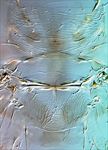Generic diagnosis
Female macropterous. Head transverse; maxillary palps 2-segmented; compound eyes with 6 pigmented facets; 3 pairs of ocellar setae, pair III near anterior margins of triangle. Antennae 8-segmented, segment I without paired dorso-apical setae, II with no long setae, sense cones on III–IV forked, III–VI with rows of microtrichia. Pronotum transverse, weakly sculptured, discal setae small; with 4 pairs of posteromarginal setae, of which one posteroangular pair sometimes longer than other pairs. Mesonotal anterior campaniform sensilla absent, median pair of setae distant from posterior margin. Metanotal sculpture irregularly reticulate, median setae arise medially; campaniform sensilla absent. Fore wing costa with setae but no cilia; first vein with 3 widely spaced setae on distal half; second vein with continuous, but widely spaced, row of setae; clavus with 4 veinal setae and one discal seta; posterior fringe cilia straight. Meso- and metafurca with spinula. Prosternal ferna widely separated; basantra membranous, without setae; prospinasternum Y-shaped. Tarsi 2-segmented. Tergites with weak transverse reticulation, posterolaterally these lines bear small microtrichia; II–VIII with setae S1 elongate, on III–VII arising on antecostal ridge; V–VII with setae S2 unusually elongate, almost as long as S1; tergites without ctenidia, VIII with no posteromarginal comb; tergite IX with posterior pair of campaniform sensilla, usually without discal microtrichia, X with no median split; pleurotergites with or without discal setae. Sternites III–VII with 3 pairs of marginal setae, discal setae varying in number 0–8.
Male similar to female; sternal pore plates present or absent.
Biological data
The single species recorded from China is associated with Lycium [Solanaceae], but the other species in the genus are associated with various semi-desert plants related to Chenopodiaceae or Zygophyllaceae.
Distribution data
The five species in this genus exhibit a remarkable disjunct distribution, with two from western USA, and three from the Mediteranean area (Minaei & Mound, 2015). One of the latter three has also been taken in India and in northern China.
Nomenclatural data
Psilothrips Hood, 1927: 198. Type species Psilothrips pardalotus Hood, 1927, by monotypy.
This genus comprises five species (ThripsWiki, 2020), with one southern Palaearctic species recorded from northern China:
bimaculatus (Priesner, 1932: 3). (Thamnothrips)
Relationship data
Thripidae sub-family Thripinae: this is a diverse group involving more than 230 genera. The species of Psilothrips are unique among Thripinae in the placement of the median pair of tergal setae on the antecostal ridge. However, the lack of long posteroangular setae on the pronotum might suggest that the genus could be a member of the Anaphothrips group (Masumoto & Okajima, 2017).
References
Masumoto M & Okajima S (2017) Anaphothrips genus-group: key to world genera, with two new species and three new records from Japan (Thysanoptera, Thripidae). Zootaxa 4272 (2): 201–220.
Minaei K & Mound LA (2015) Thysanoptera disjunct distribution between western America and the Mediterranean with a new Psilothrips species (Thripidae) from Iran. Deutsche Entomologische Zeitschrift 62 (1): 1–7.
ThripsWiki (2020). ThripsWiki - providing information on the World's thrips. <http://thrips.info/wiki/Main_Page>


